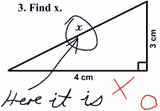Heisenburg’s Uncertainty Principle
Tricky Little Particles
Planck’s constant h is later used in Heisenburg’s uncertainty principle. The idea is that for very small particles, we can't really say exactly where it is and what momentum it has. If Δx is the uncertainty of position and Δρ is the uncertainty of momentum, then
Δx Δρ ≥ h/4π.
So to get more accuracy in position we have to give up some certainty in momentum and visa versa. We can only be so sure of where a very small particle is located or what momentum it has, but our uncertainty in bounded!
Extending Uncertainty
Since we can never be totally positive of where very small things are and what they're doing, we describe them as having a superposition of states. The particle is here, but it's also over there at the same time. The particle is moving this fast, but it's also moving that fast. It is in a variety of different states at the same time.
Schrödinger’s cat
Schrödinger’s cat is thought experiment that explains Heisenburg’s uncertainty principle. Imagine that you have a radioactive material that has a 50% chance of decaying in 1 hour and emitting a radioactive particle. This particle will trigger the release of poison that is in a sealed box with a cat. Note: this is only a thought experiment, and we love kittens, so kids, do not try this at home.
So if we seal the box, there is an equal chance that after an hour the cat is alive or the cat is dead. So we say that the cat is both alive and dead at the same time. This is a superposition of states. It is not until we open the box that the states collapse, and we know for certain that the cat is either alive or dead.





